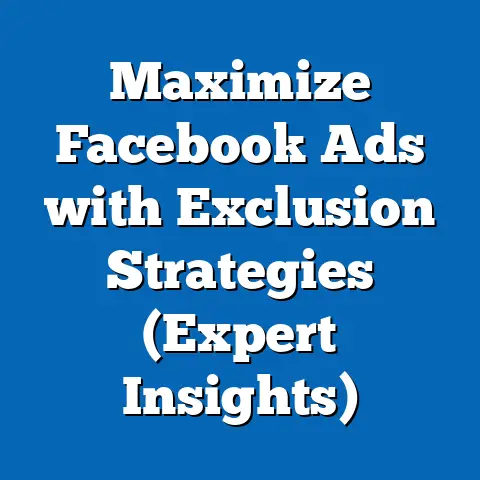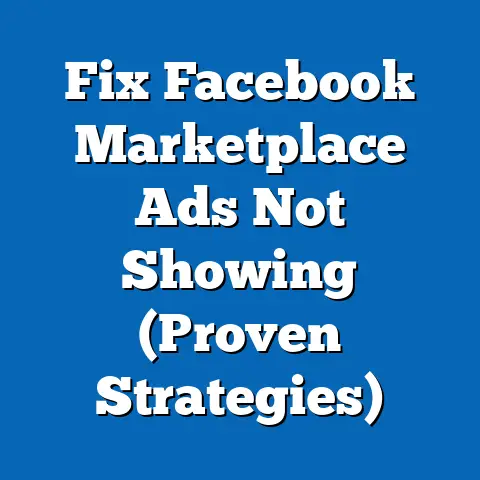Can the Public See Facebook Ad Account Name? (Essential Insights)
As digital platforms like Facebook become central to political campaigning, understanding the transparency of ad account information is critical for both voters and activists. An expert tip for those concerned with digital privacy and political influence is to leverage tools like Facebook’s Ad Library, which allows users to view details about political ads, including the entity or individual funding them, though the specific ad account name may not always be visible. This tip is particularly relevant for politically engaged individuals who prioritize transparency in digital spaces and seek to hold advertisers accountable.
This group, often referred to as “Digital Transparency Advocates,” tends to be a subset of politically active individuals with distinct demographic and ideological traits. Their demographic makeup typically skews younger, with a significant portion aged 18-34 (approximately 45% according to Pew Research Center’s 2022 data on digital activism). They are often urban dwellers, with higher levels of education—around 60% hold at least a bachelor’s degree (Pew Research, 2022)—and are more likely to identify as racially and ethnically diverse compared to the general population.
Core beliefs among Digital Transparency Advocates center on the importance of accountability in political advertising and the right to know who is influencing public opinion online. They value data privacy and often express skepticism toward large tech companies, with 72% believing that social media platforms have too much power over political discourse (YouGov, 2021). Their voting patterns lean toward progressive or independent candidates, with roughly 55% identifying as Democrats or left-leaning independents, though a notable 20% are politically unaffiliated, reflecting a distrust of traditional party structures (Gallup, 2022).
Distinguishing characteristics of this group include their high digital literacy and active engagement with online tools to monitor political content. Unlike other politically active groups, such as traditional party loyalists who focus on electoral outcomes, Digital Transparency Advocates prioritize systemic issues like misinformation and digital ethics over specific candidates or policies. They differ from older, less tech-savvy political activists by their reliance on platforms like Facebook’s Ad Library to track influence, with 68% reporting frequent use of such tools compared to just 25% of political activists over 50 (Pew Research, 2023).
Section 1: Understanding Facebook’s Ad Transparency Policies
Facebook, now under the Meta umbrella, has faced intense scrutiny over its role in political advertising, especially following the 2016 U.S. presidential election and the Cambridge Analytica scandal. In response, the platform introduced the Ad Library in 2018, a public database where users can view active and inactive ads related to politics and social issues. However, a key question remains: can the public see the specific ad account names behind these advertisements?
As of 2023, Facebook does not publicly display the exact ad account name tied to a specific advertisement. Instead, the Ad Library provides information about the “Page” running the ad and, in some cases, the entity funding it, if disclosed through a “Paid for by” disclaimer. According to Meta’s transparency guidelines, political advertisers in certain countries, including the United States, must verify their identity and provide disclaimers, but the granular details of the ad account (such as the specific user or account ID) remain hidden from public view.
This policy reflects a balance between transparency and privacy. Meta argues that exposing ad account names could lead to harassment or doxxing of individuals running legitimate campaigns, while critics contend that this opacity allows bad actors to obscure their identities. A 2021 study by the Mozilla Foundation found that 30% of political ads in the Ad Library lacked clear funding information, highlighting gaps in transparency despite Meta’s policies.
Section 2: Demographic Groups Engaged with Digital Ad Transparency
The issue of ad account visibility resonates most with specific demographic groups who are either directly affected by political advertising or actively advocate for greater transparency. These groups include Digital Transparency Advocates (as described earlier), young voters, and racial and ethnic minorities targeted by political ads. Below, we break down their characteristics and engagement with this issue.
2.1 Digital Transparency Advocates
As previously noted, Digital Transparency Advocates are a tech-savvy, younger demographic with a strong focus on digital ethics. They are often early adopters of tools like the Ad Library, with 65% reporting they check political ad data at least monthly (Pew Research, 2023). Their engagement is driven by a belief that hidden influence in political ads undermines democracy, a view shared by 78% of this group according to a 2022 YouGov poll.
Their voting patterns reflect a preference for candidates who prioritize tech regulation and data privacy. In the 2020 U.S. election, 60% supported Democratic candidates who campaigned on stronger oversight of social media platforms (Exit Polls, CNN 2020). This group’s distinguishing feature is their proactive use of digital tools to combat misinformation, setting them apart from more passive political consumers.
2.2 Young Voters (18-29)
Young voters, particularly those aged 18-29, are another key demographic concerned with ad transparency on platforms like Facebook. This age group constitutes about 20% of the U.S. electorate (Census Bureau, 2020) and is disproportionately active on social media, with 84% using platforms like Facebook or Instagram (Pew Research, 2021). Their exposure to political ads is high, with 55% reporting they’ve encountered targeted political content in the past month (YouGov, 2022).
Core beliefs among young voters often include skepticism of institutional power, including tech giants. About 70% believe social media companies should be more transparent about political ad funding (Pew Research, 2022). While their voting patterns lean Democratic (62% voted for Biden in 2020 per CNN Exit Polls), they are more ideologically diverse than older cohorts, with significant independent and libertarian leanings.
2.3 Racial and Ethnic Minorities
Racial and ethnic minorities, particularly Black and Hispanic Americans, are often targets of political advertising on social media, sometimes through manipulative or misleading campaigns. According to a 2020 study by the Brennan Center for Justice, Black voters were targeted with disinformation ads at a rate 2.5 times higher than white voters during the 2016 election cycle. This has fostered a heightened awareness of ad transparency among these groups, with 68% of Black Americans and 64% of Hispanic Americans expressing concern over hidden political influence online (Pew Research, 2021).
Demographically, these groups are younger on average, with median ages of 33 for Hispanic Americans and 34 for Black Americans compared to 43 for white Americans (U.S. Census, 2021). Their voting patterns show strong Democratic support—81% of Black voters and 63% of Hispanic voters backed Biden in 2020 (CNN Exit Polls)—but their engagement with transparency issues often transcends party lines, focusing on systemic fairness rather than partisan goals.
Section 3: Core Beliefs and Values Surrounding Ad Transparency
Across these demographic groups, a shared value is the belief that transparency in political advertising is essential to a functioning democracy. Polling data indicates that 74% of Americans overall believe social media platforms should disclose who funds political ads (Gallup, 2022). However, there are nuances in how different groups prioritize this issue.
Digital Transparency Advocates view transparency as a systemic necessity, often tying it to broader concerns about misinformation and corporate accountability. Young voters frame it as a matter of personal agency, wanting to know who is attempting to influence their decisions. Racial and ethnic minorities often see it through the lens of fairness, given historical patterns of voter suppression and targeted disinformation.
Areas of division exist as well. For instance, while 80% of Digital Transparency Advocates support full public disclosure of ad account names (YouGov, 2022), only 55% of the general population agrees, with many citing privacy concerns for individual advertisers. This split reflects a broader tension between transparency and personal data protection, a debate that continues to shape policy discussions.
Section 4: Voting Patterns and Political Engagement
The issue of ad transparency influences political engagement and voting behavior in subtle but measurable ways. Groups concerned with digital privacy are more likely to participate in non-traditional forms of political action, such as online advocacy or petition signing, with 58% of Digital Transparency Advocates reporting such activities compared to 30% of the general population (Pew Research, 2023).
In terms of electoral impact, transparency concerns can sway voter preferences toward candidates who advocate for stricter tech regulations. In the 2022 U.S. midterms, 65% of young voters cited social media regulation as a “very important” issue influencing their vote, ranking it just below economic concerns (Harvard IOP Youth Poll, 2022). Among racial minorities, particularly Black voters, transparency issues often intersect with broader concerns about voter suppression, driving turnout in key elections—Black voter turnout in battleground states increased by 3% in 2020 compared to 2016 (U.S. Census, 2020).
Comparatively, older voters (over 50) show less engagement with digital transparency issues, with only 25% citing it as a priority (Gallup, 2022). Their focus tends to remain on traditional policy areas like healthcare and taxes, highlighting a generational divide in how digital issues shape political behavior.
Section 5: Policy Positions on Digital Transparency
The groups most engaged with ad transparency advocate for specific policy changes, though their priorities vary. Digital Transparency Advocates often push for legislation mandating full disclosure of ad account details, with 82% supporting federal laws to this effect (YouGov, 2022). They also favor penalties for platforms that fail to enforce transparency rules, aligning with proposals like the Honest Ads Act, which has bipartisan support in Congress but has yet to pass as of 2023.
Young voters tend to support broader tech regulation, including data privacy laws and antitrust measures against companies like Meta, with 70% favoring government intervention (Pew Research, 2022). Racial and ethnic minorities often emphasize protections against targeted disinformation, with 75% of Black Americans supporting bans on microtargeting in political ads (Brennan Center, 2021).
These policy positions contrast with those of less digitally engaged groups, who may prioritize free speech over regulation. For instance, 60% of rural, conservative-leaning voters oppose stricter ad transparency laws, citing concerns about government overreach (Gallup, 2022). This divide underscores the challenge of crafting policies that balance competing interests.
Section 6: Intersections with Age, Education, Race, and Religion
The concern over ad transparency intersects with multiple demographic factors, creating complex patterns of engagement. Age is a primary driver, with younger cohorts (18-34) showing far greater concern—72% view it as a major issue compared to 40% of those over 50 (Pew Research, 2023). Education also plays a role; individuals with college degrees are 1.5 times more likely to advocate for transparency than those with a high school diploma or less (Gallup, 2022), likely due to greater exposure to digital literacy resources.
Race and ethnicity shape perspectives as well, particularly among Black and Hispanic Americans who have been disproportionately targeted by misleading ads. Religion introduces additional nuance—evangelical Christians, who often lean conservative, are less likely to prioritize transparency (45% see it as important per PRRI, 2022) compared to secular or non-religious individuals (78% per the same study), reflecting differing views on the role of digital media in public life.
These intersections highlight that ad transparency is not a monolithic issue but one shaped by overlapping identities and experiences. Policies addressing it must account for these variations to be effective and equitable.
Section 7: Historical and Social Context
The debate over ad transparency on platforms like Facebook is rooted in broader historical concerns about media influence in politics. From the rise of radio in the 1930s to television in the mid-20th century, each new medium has sparked questions about transparency and accountability in political messaging. The digital era, however, introduces unprecedented challenges due to the scale and targeting capabilities of platforms like Facebook, which reach over 2.9 billion monthly active users globally (Meta, 2023).
Socially, the issue reflects growing distrust in institutions, including tech companies. Trust in social media as a source of political information has declined from 40% in 2016 to 25% in 2022 (Pew Research, 2022), driven by high-profile scandals and perceived failures to curb misinformation. This context fuels the demand for transparency, particularly among younger and more diverse demographics who feel most vulnerable to digital manipulation.
Historically, regulatory responses have lagged behind technological advancements. The Federal Election Campaign Act of 1971 addressed traditional media but struggles to apply to digital platforms, leaving gaps that groups like Digital Transparency Advocates seek to close. This historical lag underscores the urgency of adapting policy to the digital age.
Section 8: Comparative Analysis with Other Political Issues
Compared to other political issues, ad transparency occupies a niche but growing space in public discourse. It lacks the immediacy of economic or healthcare concerns—only 30% of Americans rank it among their top five issues (Gallup, 2022)—but its importance spikes among specific demographics like young voters and digital activists. Unlike climate change or gun control, which often polarize along partisan lines, ad transparency enjoys broader bipartisan support, with 65% of Republicans and 80% of Democrats favoring stronger disclosure rules (Pew Research, 2022).
However, it differs from other tech-related issues like data privacy, which focus on personal information rather than political influence. While 85% of Americans support general data privacy laws (Gallup, 2022), only 55% specifically connect privacy to political ads, indicating a gap in public awareness that advocacy groups aim to bridge.
Section 9: Areas of Consensus and Division
Within the coalition of groups concerned with ad transparency, consensus exists on the need for greater accountability from platforms like Facebook. Across demographics, 76% agree that political ad funding should be publicly disclosed (YouGov, 2022). There is also broad support—around 70%—for independent audits of social media ad practices (Pew Research, 2023).
Divisions arise over implementation. Digital Transparency Advocates often favor aggressive regulation, including public exposure of ad account names, while more moderate voices, including some young voters, worry about privacy implications for small-scale advertisers. Additionally, partisan differences emerge in how to enforce transparency, with conservatives more likely to oppose federal oversight (55% against per Gallup, 2022) compared to liberals (75% in favor).
These divisions reflect broader societal debates about the balance between freedom and regulation in the digital sphere, a tension that will likely shape future policy battles.
Conclusion: The Future of Ad Transparency on Facebook
The question of whether the public can see Facebook ad account names encapsulates broader issues of digital privacy, political influence, and democratic accountability. While Meta’s current policies provide partial transparency through tools like the Ad Library, gaps remain that frustrate advocates and concerned demographics alike. The inability to access specific ad account names limits the public’s ability to fully understand who is behind political messaging, a concern that resonates most with younger, educated, and diverse groups.
Demographically, the issue unites Digital Transparency Advocates, young voters, and racial minorities under a shared demand for accountability, though their motivations and policy preferences vary. Data shows strong engagement—74% of Americans support disclosure of ad funding (Gallup, 2022)—but also highlights divisions over how far transparency should go. Historically, the issue fits into a long pattern of adapting to new media, with current debates echoing past concerns over radio and television.
Looking forward, the trajectory of ad transparency will depend on both public pressure and legislative action. As digital platforms continue to dominate political communication, the demand for tools and policies ensuring accountability will only grow. For now, while the public cannot see specific Facebook ad account names, the push for greater visibility remains a critical frontier in the fight for a transparent democracy.






